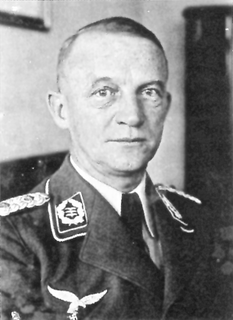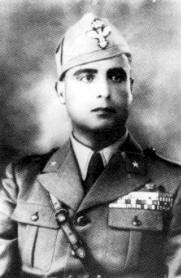
The Afrika Korps or German Africa Corps was the German expeditionary force in Africa during the North African Campaign of World War II. First sent as a holding force to shore up the Italian defense of its African colonies, the formation fought on in Africa, under various appellations, from March 1941 until its surrender in May 1943. The unit's best known commander was Field Marshal Erwin Rommel.

The Battle of Anzio was a battle of the Italian Campaign of World War II that took place from January 22, 1944 to June 5, 1944. The operation was opposed by German forces in the area of Anzio and Nettuno.

Albert Kesselring was a German Generalfeldmarschall of the Luftwaffe during World War II who was subsequently convicted of war crimes. In a military career that spanned both world wars, Kesselring became one of Nazi Germany's most highly decorated commanders, being one of only 27 soldiers awarded the Knight's Cross of the Iron Cross with Oak Leaves, Swords and Diamonds.

The Allied invasion of Italy was the Allied amphibious landing on mainland Italy that took place from 3 September 1943, during the Italian campaign of World War II. The operation was undertaken by General Sir Harold Alexander's 15th Army Group and followed the successful Allied Invasion of Sicily. The main invasion force landed around Salerno on 9 September on the western coast in Operation Avalanche, while two supporting operations took place in Calabria and Taranto.

Ferdinand Schörner was a German military commander who held the rank of Generalfeldmarschall in the Wehrmacht of Nazi Germany during World War II. He commanded several army groups and was the last Commander-in-chief of the German Army.

Ugo Cavallero was an Italian military commander before and during World War II. He was dismissed from his command due his lacklustre performance, and was arrested upon the fall of Mussolini's regime. Cavallero was later freed by the Nazi Germans, and served under the collaborationist government until his death in 1943.

The 90th Light Infantry Division was a light infantry division of the German Army during World War II that served in North Africa as well as Sardinia and Italy. The division played a major role in most of the actions against the British Eighth Army in the Western Desert Campaign and eventually surrendered to the Allies in the final stages of the Tunisia Campaign in May 1943. It was re-constituted later in 1943 and deployed to Sardinia and when the expected Allied invasion of Sardinia failed to materialise, the division was moved to Italy. It was engaged in actions against the Allies in Italy from 1943 to April 1945 when the division was listed as "destroyed" in the Po River valley.

The 44th Infantry Division was formed on 1 April 1938 in Vienna, about two weeks after the Anschluss of Austria. It first saw combat at the start of the war in the Invasion of Poland, and also took part in the Battle of France in 1940. After a 9-month period of coastal defence the division was transferred East. On 22 June 1941, the division took part in the invasion of the Soviet Union, attached to Army Group South. It remained in the east after the failure of "Operation Barbarossa", taking part in defensive actions for the winter against the Soviet Army offensives near Izum and Kharkov. Refurbished, the division participated in the German summer offensive, and was subsequently destroyed with the 6th Army at Stalingrad in January 1943.

This article is about the Royal Italian Army which participated in the Second World War. The Royal Italian Army was reformed in 1861 and existed until 1946. The Royal Army started with the unification of Italy (Risorgimento) and the formation of the Kingdom of Italy. It ended with the dissolution of the monarchy. The Royal Army was preceded by the individual armies of the independent Italian states and was followed by the Italian Army of the Italian Republic.

Carlo Geloso, was an Italian general during the Second World War. In 1939, he assumed command of the Italian forces in Albania. In 1940, he served as commander of the 11th Army during the Greco-Italian War. He was the commander of the Italian occupation forces in Greece from 1941 to 1943. After Italy joined the Allies, he became a German prisoner-of-war. After the German surrender, he was briefly imprisoned by the Soviets but was released in 1946.

Operation Achse, originally called Operation Alaric, was the codename for the German operation to forcibly disarm the Italian armed forces after Italy's armistice with the Allies on 3 September 1943.

Hellmuth Felmy was a German general and war criminal during World War II, commanding forces in occupied Greece and Yugoslavia. A high-ranking Luftwaffe officer, Felmy was tried and convicted in the 1948 Hostages Trial.
Hans-Hellmuth Pfeifer was a German general during World War II. A veteran of World War I, he held higher command positions in WWII, among other, that of the 65th Infantry Division in Italy, selecting its hand grenade symbol which earned the nickname "The Hand Grenade Division."

Giacomo Carboni was an Italian general who was the commander of Corpo d'armata motocorazzato deployed around Rome in the early days of September 1943.
Rudolf Hübner was a German general during World War II. He was a recipient of the Knight's Cross of the Iron Cross of Nazi Germany.
Comando Supremo was the highest command echelon of the Italian armed forces between June 1941 and May 1945. Its predecessor, the Stato Maggiore Generale, was a purely advisory body with no direct control of the several branches of the armed forces and with very little staff. Created amidst the exigencies of World War II, Comando Supremo was a large organization with several departments and operational command of the armed forces on the active fronts. At the end of the war, it was reduced to a purely advisory role again.

Mario Arisio was an Italian general who served in the Italo-Turkish War, World War I, the Second Italo-Ethiopian War and World War II.

Giovanni Marciani was an Italian general during World War II.

Gioacchino Solinas was an Italian general during World War II. He is best known for his leadership of the Grenadiers of Sardinia during the defense of Rome after the Armistice of Cassibile; he later joined the Italian Social Republic.
Archimede Mischi was an Italian Blackshirt general during World War II.
















